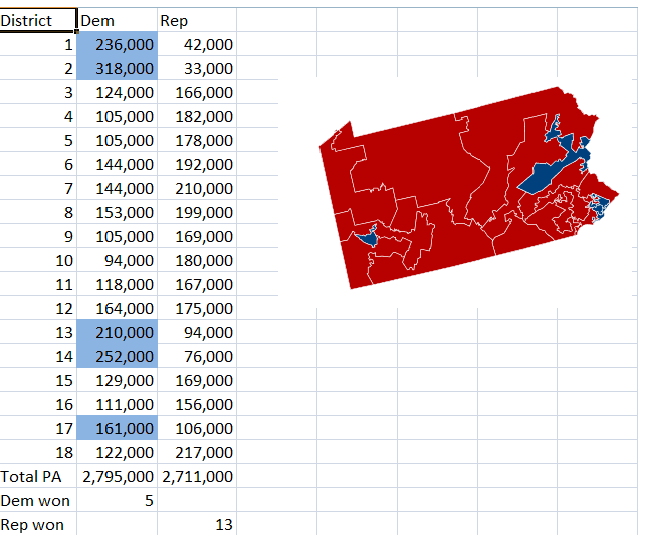Gerrymandering Thwarts Majority Rule
Gerrymandering: the dividing of a state, county, etc., into election districts so as to give one political party a majority in many districts while concentrating the voting strength of the other party into as few districts as possible. Dictionary.com
Why is gerrymandering a problem we should care about?
Primarily, gerrymandering thwarts election results—it denies majority rule. A good example is Pennsylvania’s 2012 election for US House representatives. More votes were cast for Democratic candidates but, due to gerrymandering the Republicans won 13 seats, while the Democrats won only 5!
Secondarily, it exaggerates partisan differences. Winning the primary, in which the most extreme political elements vote, is often tantamount to winning the general election.
State-Wide Elections
Drawing election districts should be removed from the sphere of political influence. Perhaps all elections should be state-wide rather than by districts controlled by politicians. In this case, Pennsylvania would have still have 18 house seats, but voters in any part of the state could vote for any representative that appeal to them. If a candidate wanted to focus his/her positions on those of Philadelphia, nothing would stop them, although they would get votes mainly from that area.
A side benefit of state-wide elections would be that wide-spread, but minority interests that could never win a majority in a district, could occasionally gain a representative of the 18 available and have their voices heard.
Gerrymandering Election Result
The map below shows the gerrymander result in the 2012 PA election. Note that the districts were drawn such that votes for Democratic candidates were overwhelming concentrated in four districts and Republican voters were very sparse in those districts. That is, the lines were drawn to put the Republican voters in districts where Democrats were not so concentrated.

Democracy Rule or Does It?
In Pennsylvania, more votes were cast for Democratic candidates (2.795M) than Republicans (2.711M), but through gerrymandering only 5 Democratic were sent to this Congress while 13 Republicans were sent. The notion that the majority of voters will have their voices heard is subverted in our federal representative system.
Votes in Congress for Pennsylvania will have 13 Republicans overriding the 5 Democrats who represent more than half of the state’s voters. A clear contraversion of majority rule.



4 thoughts on “Gerrymandering Thwarts Majority Rule”